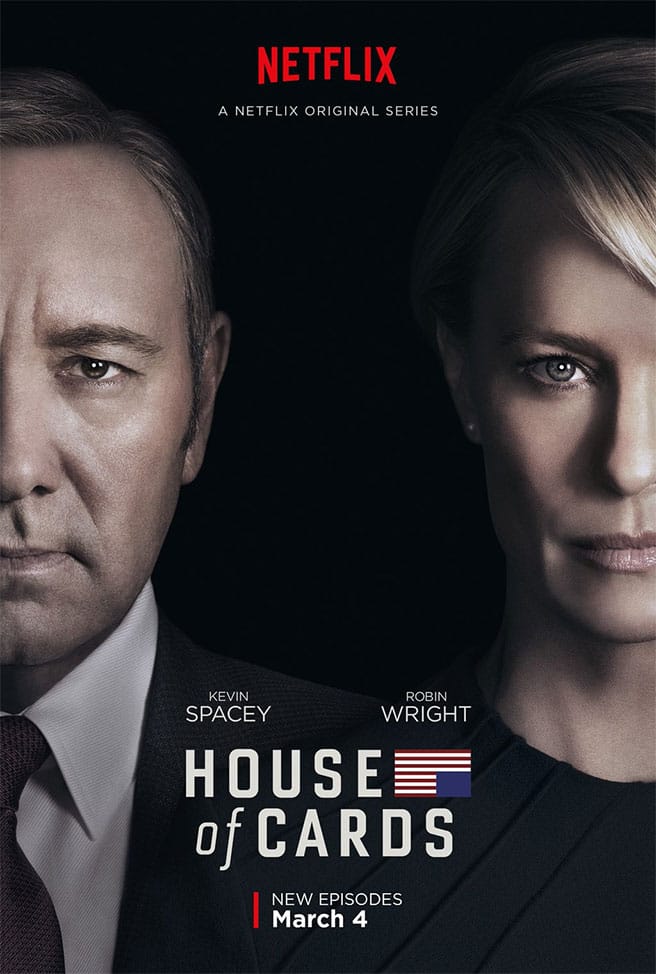
Bouncing back after a lethargic and introspective third season, House of Cards – the very definition of a guilty pleasure – continues to comb the dark recesses of vice hidden beyond the surface of Washington, D.C., embodied by the show’s power couple, Frank and Claire Underwood, unrivaled political operators who together climbed the rungs of politics all the way to the White House. This season opens with Frank and Claire separated and posits that, after they destroyed all those in the path to the presidency, their worst enemies are each other.
The show, the last by original showrunner and playwright Beau Willimon, engenders a strong love-hate critical response. Its politics are ludicrous and cynical, its characters gullible and melodramatic, its drama alternatively flaccid and hammy.
On a network, this may be mitigated, but on the wild west of Netflix, there are no rules. Willimon’s eloquence and loquaciousness (two words I’m sure are at the top of his vocabulary list) are on full display. You like it or you don’t. I like it. And judging by the way the season begins, Willimon’s thoughts on masturbatory writing are quite clear to viewers.
I like how operatic it makes it, how mythic the tone is and how it relishes in rule-breaking, both with its characters’ decisions and its dramatic potential. More than anything, every event on House of Cards, no matter how improbable, can be framed by as a choice between “hard” and “soft” sci-fi, i.e. do you want your science fiction realistic as hell or entertaining as hell?
Cards fall firmly in the latter category. Yes, some of the plot leaps can be speculative and tenuous but I have to say, amidst a presidential election stranger than fiction, it’s almost a little hurtful the operatic and melodramatic show didn’t dream up such a vain and vile creature as Donald Drumpf.
Drumpf’s theatrical bombast would fit right in were he to crossover. Indeed, upon re-watching the first three seasons in preparation for the fourth, I found remarkable similarities beyond equally-fictional strongmen – Underwood and Drumpf. And I think the rising tide of American authoritarianism may have something to do with the fact that as consumers, Americans love themselves an Ubermensch.
The frightening state of our reality aside, a ton of Twitter snark is thrown the show’s way by people who look past its addictive nature and binge-watch sheen and see just the ugliness. When I look though, I see a gloriously messy tapestry as unstable and perilous as the title suggests. The way Willimon and his writing team weave their multitude of storylines and the tacit refusal to leave loose ends untied is ambitious and I fully appreciate the effort.
Thus, the show exists to fulfill a simple function: a writer given Washington D.C. as a setting and asking “what could people with no scruples get away with?” With director David Fincher having set the macabre pitch-black humor undercurrent, Frank became our Charon, ferrying audiences through the canals of filth that line the Capitol all the way to the Oval Office. Despite his evil, we root for him.
For a refresher on last season, check out my Season 3 review.
(SPOILER WARNING FOR HOUSE OF CARDS SEASON 4. DON’T READ ANY FURTHER UNLESS YOU HAVE WATCHED ALL OF SEASON 4!)
After growing more tyrannical as his presidency drags on, Frank (Kevin Spacey) managed to drive away most of his allies, including Claire (Robin Wright) who up and leaves him for sanctuary with her mother (Ellen Burstyn) at her family home in Texas. Meanwhile, Frank is hanging on by a thread in his bid for the Democratic nomination against Heather Dunbar (Elizabeth Marvel). And to make things worse, old grudges and faces long thought buried bubble back to the surface, threatening to reveal the rotten foundation that could bring the Underwood’s house of cards crashing down.
Despite its aspirations as a dark mirror West Wing, what it actually does is take B-movie grime to the capital, dirtying whatever image of propriety Washington, D.C. had left. It revels in unmasking the presidential as the pernicious and puerile while simultaneously making the viewer question basic morality in the face of Frank’s brand of ruthless pragmatism.
It covers the Oval Office in spittle and coffee, piss and shit, smoke and slime. It’s portrayed as Giger-meets-Lovecraft, a deliberately-disgusting blend manifesting as a Freudian nightmare, literally in the case of Chapter 44. Said nightmare, taking place while Frank is in a coma post-assassination attempt, also showcases a brilliant use of the cameo to bring back the specters of journalist Zoe Barnes (Kate Mara) and congressman Peter Russo (Corey Stoll), Frank’s playthings he murdered along his dark voyage.
I was dully surprised by how the mega-cliffhanger of Claire leaving Frank is resolved within three or four episodes. Surprised because why was it such a big deal to end a season if it’s gonna be resolved immediately and dully because of course Claire isn’t going to leave Frank unless she suddenly stopped liking power. Someone as politically-minded as Claire and with the desire for significance she has would know better than to divorce Frank.
It was good to see her assert herself in the relationship and ultimately for Frank to recognize her validity. For all his monstrosity, Frank bond with Claire is immeasurably human. Breaking that down last year, while perhaps dramatically necessary, denied fans – and Frank – what they needed, which was Claire’s partnership and trust (although, truthfully, it was also that the show took 13 hours over somewhat-repetitive marital strife to get there. Not cost-effective storytelling by any means).
Another way the series recovers from Season 3 is by putting Doug Stamper (Michael Kelly) at Frank’s side. Like Claire, the unshakable trust between the two men is vicariously how we care about Frank. Perhaps more importantly, Frank’s plotting is boring without Doug carrying it out. Likewise, Claire hires a whip-smart Texan campaign strategist Leann Harey (a welcome-if-underutilized Neve Campbell) to be her Girl Doug. It’s a big happy fucked-up family – which also includes novelist/new Meechum Thomas Yates (Paul Sparks).
The show embraces the farcical aspect of nominating Claire as Frank’s VP (in reality, the Bobby Kennedy Act prevents people who are related from appointing each other or running together) and works it into the characters. The Underwoods, when hatching the plan, act as the voices of the writers, basically saying “We know this is ridiculous but the show is about us and we just spent 3 years murdering and scheming our way to the presidency without anyone stopping us so fuck it, let’s go for it.”
Speaking of the election, the second half of the season focuses on a fictional 2016 race that looks comparatively sane next to reality. It’s hard to cast adversaries for the Underwoods and make them seem formidable when we all know they’ll steamroll them eventually, but the Conways come close.
William Conway (Joel Kinnaman, fantastic casting here) is exactly the candidate the Republicans of our world wish they had – a 40-year-old ex-Marine and Governor of the very blue state of New York. He embraces new media, shoving pictures and videos of his British wife and kids on his Twitter and Instagram. Despite their youthful, family-centric veneer, the couple is not so different from the Underwoods; one the latter practice secrecy, Conway’s facade is hidden in plain sight and he is a slave to the attention.
The other major storyline concerns the journalists and the growing web of broken people the Underwoods have created. In addition to Stoll and Mara, Sebastian Arcelus (Lucas Goodwin), Constance Zimmer (Janine Skorsky), Boris McGiver (Tom Hammerschmidt) Michel Gill (fmr. president Garrett Walker) and Gerald McRaney (businessman Raymond Tusk) are among the many Season 1 and 2 players to make reappearances. Like the recent Oscar-winner Spotlight, it’s good to see old-fashioned investigative journalism given relevance and clarity in popular culture.
It’s a good ending and a good way for Beau Willimon to bow out, as this is his last season. He spent a presidential term at the helm of one of planet Earth’s most popular shows as a first-time showrunner. It can’t have been easy. Just like his characters, he goes for broke this season, leaving it all on the field, and (insert third sports metaphor).
The finale, penned by Willimon, pulls the thread on the Underwoods’ cover-ups, exposing them to the world. But instead of a decisive end, it does what the show does best – let Frank and Claire pull a rabbit out of the hat to survive. This rabbit just so happens to be war.
(Re-watching Season 3, I got chills when Frank told audiences in one of his asides he would kill Putin expy Viktor Petrov if it wouldn’t trigger World War III. At the time I thought world war was too outlandish even for this show but now? I think it’s genius that the question was queued)
We don’t want the Underwoods to lose. We don’t want the game to be over. And, seeing as the show as renewed weeks prior to the premiere, Netflix agrees.
Grade: B+
Ranking the seasons:
- Season 1 – A
- Season 4 – B+
- Season 2 – B
- Season 3 – C

Be First to Comment